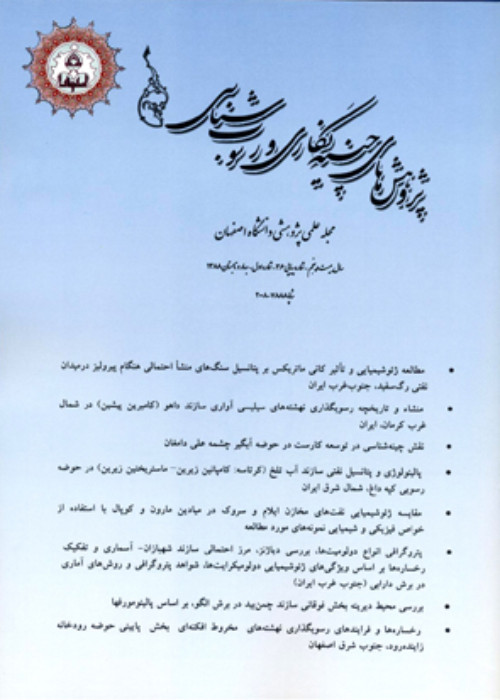New finding on the biostratigraphy and paleoecology of the Farrokhi Formation in northwest of Khur, Central Iran, based on palynomorphs and foraminifera
Author(s):
Article Type:
Research/Original Article (دارای رتبه معتبر)
Abstract:
Introduction
Upper Cretaceous deposits of Iran do not have the same facial features everywhere. Indeed it seems that contrary to the same conditions of the lower Cretaceous the upper Cretaceous sedimentary basins were separated from each other and had a special condition on each basin accordingly, except for the Zagros and Koppeh-Dagh they have not been officially named (Aghanabati, 2006). Several sedimentary facies have been reported to be existing during the Cretaceous period. The sequences formed in these basins in different regions, although are similar in terms of fossil content but, they are very different in terms of petrography, thickness and deposition time. Also, Cretaceous rocks are diverse in Central Iran, with varying thickness and age, and have not been officially named yet and are generally investigated. Since the most complete Cretaceous sequence in Central Iran was in the Yazd block and in the Khur area, we decided that the Farrokhi formation (Aistove et al., 1984), which is the youngest Cretaceous rock unit in the Khur region, should be studied. The Farrokhi formation is one of the Upper Cretaceous rocky units, with a variable thickness of 65 to 180 meters (Aistove et al., 1984), and made up of limestone, limestone with rubble or strips which is characterized by abundance of echinoid and bivalves. The lowest part of this formation is reportedly 45 to 120 meters of marl with sandstone layers. Based on the brachiopods, bivalves and echinoid, the formation has been aged as Senonian-Danian (Aistove et al., 1984). Therefore, in order to complete the stratigraphic and paleontological data, the Farrokhi formation is selected and studied. The formation is the youngest Cretaceous rock unit in the Khur, Anarak and Jandag areas, which in most areas there is a marl body in its base. The Farrokhi formation in this section is 233 meters thick and is placed continuously on limestones of Haftuman formation while, it upper contact with the limestones of the Chupanan formation is conformable. The formation has been divided into four informal divisions.
Materials and methods
In order to study lithostratigraphy and biostratigraphy of the Farrokhi informal formation, an outcrop of the formation was selected and sampled at Azizabad village northwest of Khur city. A total of 81 rock samples were taken of them 25 samples for palynological studies, 17 samples were washed for their foraminiferal contents and 39 samples were used to prepare thin sections.
Discussion of Results & Conclusions
The Azizabad section is located 400 kilometers northeast of Isfahan and on the edge of the great desert, northwest of the city of Khur. In this section, the Farrokhi formation conformably overlay limestones of the Haftuman fm. while, it is in turn overlain by the Chupanan formation. The Farrokhi formation at this section is mostly composed of marl and limestone so that the lower part is formed from green to buffy marls containing sponges and in the upper parts from marly limestones and marly intercalation which turn into the massive limestones of the Chupanan formation.Study of the palynological slides showed that only two samples in the lower part of the formation were rich in dinoflagellate cysts containing 46 genera and 71 species. The assemblage is well fitted in the Odontochitina costata Interval Zone according to the previous reports of this cyst zone.
Two foraminiferal biozones were also differentiable according to the assemblages and index forms identified. These include:Globotruncana aegyptiaca Interval Zone (Late to Latest Campanian) and Gansserina gansseri Interval Zone (Latest Campanian to Early Maastrichtian).
According to the fossil set, the Farrokhi formation at this locality is of middle Campania to Maastrichtian age.
The study of the three major groups of palynological elements, as well as the organic factors, the ratio of the transparent (AOM) to the marine elements and the lability factor in the two samples indicated that this part of the section was deposited in an open shallow marine environment forming a transitional zone to the deepest part of the basin in which planktonic foraminifera bloomed.
Keywords:
Language:
Persian
Published:
Stratigraphy and Sedimentology Researches, Volume:34 Issue: 3, 2018
Pages:
1 to 20
magiran.com/p1970902
دانلود و مطالعه متن این مقاله با یکی از روشهای زیر امکان پذیر است:
اشتراک شخصی
با عضویت و پرداخت آنلاین حق اشتراک یکساله به مبلغ 1,390,000ريال میتوانید 70 عنوان مطلب دانلود کنید!
اشتراک سازمانی
به کتابخانه دانشگاه یا محل کار خود پیشنهاد کنید تا اشتراک سازمانی این پایگاه را برای دسترسی نامحدود همه کاربران به متن مطالب تهیه نمایند!
توجه!
- حق عضویت دریافتی صرف حمایت از نشریات عضو و نگهداری، تکمیل و توسعه مگیران میشود.
- پرداخت حق اشتراک و دانلود مقالات اجازه بازنشر آن در سایر رسانههای چاپی و دیجیتال را به کاربر نمیدهد.
دسترسی سراسری کاربران دانشگاه پیام نور!
اعضای هیئت علمی و دانشجویان دانشگاه پیام نور در سراسر کشور، در صورت ثبت نام با ایمیل دانشگاهی، تا پایان فروردین ماه 1403 به مقالات سایت دسترسی خواهند داشت!
In order to view content subscription is required
Personal subscription
Subscribe magiran.com for 70 € euros via PayPal and download 70 articles during a year.
Organization subscription
Please contact us to subscribe your university or library for unlimited access!



